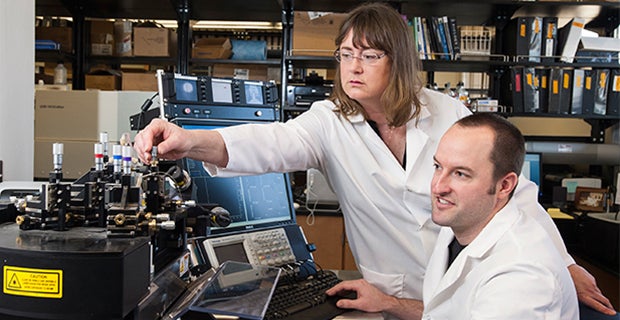
FLOW CYTOMETRY CORE FACILITY
By Becca Burke
Department of Biological Sciences
Director: Denise Wingett
Laboratory Manager/Senior Scientist: Rebecca Hermann
Website: https://www.boisestate.edu/biology/research/flow-cytometry-core-facility/
The human body is made up of more than 37 trillion cells, some of which are rarer than others. In the Boise State Flow Cytometry Core Facility, the primary function of the lab is to isolate and collect these rare cell types for analysis.
Flow Cytometry is a type of technology that is used to analyze the physical and chemical characteristics of cells and to examine, count and sort cells.
Cell components are labeled with fluorescent dye, then the cell is excited by a laser and the light emitted is measured to determine the cell properties. Although the samples are sorted primarily based on the presence of the fluorescent dye and light emitted, they also are sorted by size and granularity characteristics.
“The instrumentation in this facility is able to isolate and collect rare cell types such as stem cells or strains of bacteria from complex mixtures,” said Denise Wingett, lab director and professor for the Department of Biological Sciences.
A flow cytometer includes three main systems: fluidics, optics and electronics.
- The fluidics system operates by injecting the cell sample into the sheath fluid for delivery to the laser for interrogation. Hydrodynamic focusing of the sample within the sheath fluid allows for one cell to pass through the laser at a time.
- The optical system contains lasers, lenses and filters. As a cell passes through the laser beam it will scatter light for relative size and granularity measurements. Lasers also excite fluorochromes present in the cell sample. Lenses and filters are required to direct the scattered and excited light of specific wavelengths to various detectors for collection.
- The electronics system then converts the light signals received by the detectors. These converted light signals are then displayed on a graph like a dot plot or histogram that can be used to analyze or sort a selected cell population in the sample.
Flow cytometry has been an area of interest for Wingett for a long time. “I came to appreciate the power and versatility of flow cytometry and fluorescent activated cell sorting while I was a graduate student at Washing State University and have continued to use this technology throughout my research programs,” she said. “It is ideal for analyzing small biological samples and studying cell populations from complex mixtures from human blood or tissue samples.”
Flow cytometry has a variety of uses, including measuring DNA content, RNA versus DNA differentiation, evaluating cell viability, monitoring second messengers to determine cell activation state, and analyzing target versus non-target cells.
Currently the lab has seven separate projects where research is ongoing. The facility is used by multiple researchers and student researchers who are conducting analysis and research into areas like: cancer research, cancer metastasis, vaccine development, developmental biology, angiogenesis, autoimmune diabetes and nanobiotechnology.
Boise State students are able to use the lab to have their research samples analyzed with sponsorship from a faculty member. The labs services also are available for public use for a nominal fee.
For more information about the lab, or to see about utilizing the lab’s services, please visit the lab website at https://biology.boisestate.edu/flow-cytometry-core-facility/.
BY: KATHLEEN TUCK PUBLISHED 4:19 PM / JUNE 6, 2016